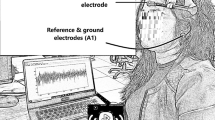Abstract
Human brain uses a complex electro-chemical signaling pattern that creates our imagination, memory and self-consciousness. It is said that Electroencephalography better known as EEG contains signatures of various tasks that we perform. In this paper we study the possibility of categorizing tasks conducted by humans from EEG recordings. The novelty of this study mainly lies in the use of very cost effective consumer grade wireless EEG devices. Three cognitive tasks were considered: text reading and writing, Math problem solving and watching videos. Twelve subjects were used in this experiment. Initial features were calculated from Discrete Wavelet Transform (DWT) of raw EEG signals. After application of appropriate dimensionality reduction, Support Vector Machine (SVM) was used for classification of tasks. DWT + Kernel PCA with SVM based classifier showed 86.09 % accuracy.
Access this chapter
Tax calculation will be finalised at checkout
Purchases are for personal use only
Preview
Unable to display preview. Download preview PDF.
Similar content being viewed by others
References
Obermaier, B., Neuper, C., Guger, C., Pfurtscheller, G.: Information transfer rate in a five-class brain-computer interface. IEEE Transactions on Neural Systems and Rehabilitation Engineering 9(3), 283–288 (2001)
Hsu, W.Y., Lin, C.H., Hsu, H.J., Chen, P.H., Chen, I.R.: Wavelet-based envelope features with automatic EOG artifact removal: Application to single-trial EEG data. Expert Systems with Applications 39(3), 2743–2749 (2012)
Nigam, V.P., Graupe, D.: A neural-network-based detection of epilepsy. Neurological Research 26(1), 55–60 (2004)
Kannathal, N., Choo, M.L., Acharya, U.R., Sadasivan, P.K.: Entropies for detection of epilepsy in EEG. Computer methods and programs in biomedicine 80(3), 187–194 (2005)
Sadati, N., Mohseni, H.R., Maghsoudi, A.: Epileptic seizure detection using neural fuzzy networks. In: 2006 IEEE International Conference on Fuzzy Systems. IEEE (2006)
Subasi, A.: EEG Signal classification using wavelet feature extraction and a mixture of expert model. Expert Systems with Applications, pp. 1084–1093 (2007)
Polat, K., Güneş, S.: Classification of epileptic form EEG using a hybrid systems based on decision tree classifier and fast Fourier transform. Applied Mathematics and Computation 32(2), 625–631 (2007)
Srinivasan, V., Eswaren, C., Sriraam, N.: Approximate entropy-based epileptic EEG detection using artificial neural network. IEEE Transaction on Information Technology in Biomedicine 11(3), 288–295 (2007)
Hotelling, H.: Analysis of a complex of statistical variables into principal components. Journal of Educational Psychology, 417–441 (1933)
Schölkopf, B., Smola, A., Müller, K.R.: Nonlinear component analysis as a kernel eigenvalue problem. Neural Computation, 1299–1319 (1998)
Balasubramanian, M., Schwartz, E.L.: The Isomap algorithm and topological stability. Science, 7 (2002)
Roweis, S.T., Lawrence, K.S.: Nonlinear dimensionality reduction by Locally Linear Embedding. Science 290(5500), 2323–2326 (2000)
Belkin, M., Niyogi, P.: Laplacian eigenmaps and spectral techniques for embedding and clustering. NIPS 14 (2001)
Sammon, J.W.: A nonlinear map** for data structure analysis. IEEE Transactions on computers 18(5), 401–409 (1969)
The, Y.W., Roweis, S.T.: Automatic alignment of hidden representations. In: Advances in Neural Information Processing Systems, pp. 841–848 (2002)
MindWave Headset. Neurosky Inc., San Jose (2014). http://store.neurosky.com/products/mindwave-1 (accessed 3 Jan 2014)
Author information
Authors and Affiliations
Corresponding author
Editor information
Editors and Affiliations
Rights and permissions
Copyright information
© 2015 Springer International Publishing Switzerland
About this paper
Cite this paper
Paul, S.K., Zulkar Nine, M.S.Q., Hasan, M., Amin, M.A. (2015). Cognitive Task Classificaiton from Wireless EEG. In: Guo, Y., Friston, K., Aldo, F., Hill, S., Peng, H. (eds) Brain Informatics and Health. BIH 2015. Lecture Notes in Computer Science(), vol 9250. Springer, Cham. https://doi.org/10.1007/978-3-319-23344-4_2
Download citation
DOI: https://doi.org/10.1007/978-3-319-23344-4_2
Published:
Publisher Name: Springer, Cham
Print ISBN: 978-3-319-23343-7
Online ISBN: 978-3-319-23344-4
eBook Packages: Computer ScienceComputer Science (R0)




